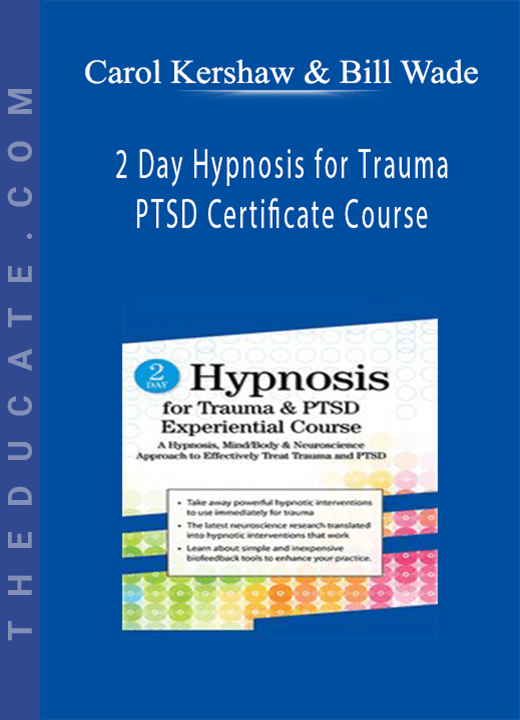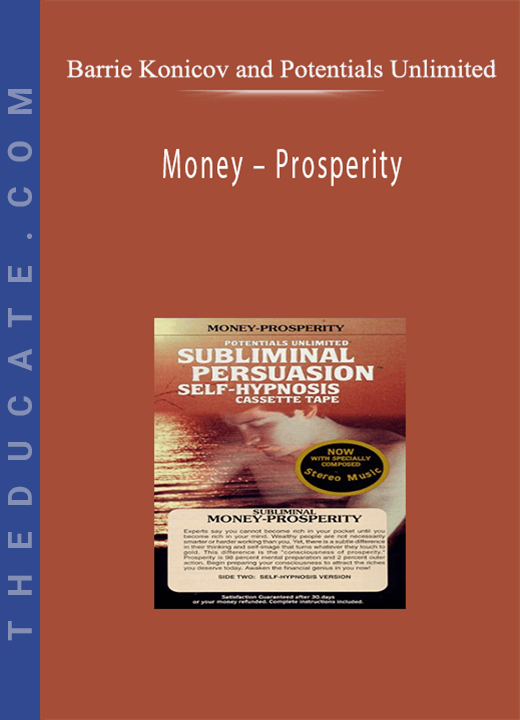Description

2 Day Hypnosis for Trauma & PTSD Certificate Course – Carol Kershaw & Bill Wade
Your clients have endured stressful and traumatic experiences which often results in less ability maintain health and to fully provide self-comfort. This course is designed to help you understand more the neurological and psychological patterns that create PSTD symptoms. This course will focus on developing strategies to help traumatized clients heal by changing these patterns.
Hypnosis is a powerful tool that you can add to your clinical toolbox for treating trauma. When it’s used with the brain in mind, hypnosis provides effective interventions to help clients interrupt negative patterns, live more in joy with the ability to self-motivate, and accomplish life goals.
During this course, special emphasis will be given to understanding how trauma affects the brain and can lead to symptoms such as anxiety, depression, panic, insomnia, obsessive-compulsive behavior and difficulty handling anger. You will learn how to treat these symptoms with the use of hypnosis.
Watch hypnosis experts and trainers, Carol Kershaw and Bill Wade, as they demystify and simplify hypnosis so you can start using it with your traumatized clients immediately. They will break down the research that supports hypnosis for trauma and teach you how to implement it into your clinical work. You will learn through demonstration, case- examples, lecture, experiential exercises and hands-on experience.
This is a course you don’t want to miss!
- Breakdown the basics of clinical hypnosis to incorporate into your practice.
- Analyze the research on hypnosis as it relates to the clinical treatment of trauma.
- Describe advances in mind/body research as it relates to trauma.
- Determine the efficacy of focused attention on alleviating symptoms of trauma and PTSD.
- Analyze the neurophysiology of trauma in relation to assessment and treatment planning.
- Integrate three hypnotic strategies to facilitate trauma- symptom resolution with clients.
- Demonstrate how deep hypnotic states can help calm a client’s anxiety, panic and reactivity.
- Describe how trauma symptoms may act as negative hypnotic trances and how that may affect therapeutic outcomes.
- Intervene on emotional instability with three hypnotic protocols to improve client level of functioning.
- Describe how you can alter client’s emotional states with hypnosis to help reduce trauma symptoms.
- Determine how the differences among secure, ambivalent, anxious and disorganized attachment categories can better inform clinical assessment of trauma.
- Modify attachment patterns with hypnosis to help move clients forward in clinical treatment.
Neurophysiology of Trauma/PTSD
- Impact on the nervous system
- Impact of trauma on the brain
- Impact of stress on the brain
- Vagal Nerve Activation-Stephen Porges
Adverse Childhood Experiences (ACES)
- Intense and prolonged trauma
- Developmental trauma
- Seizure activity with trauma
Trauma and Attachment
- Attachment styles
- Trauma and dissociation style attachment
- Attachment and relationships
Latest Neuroscience Research on Body/Mind Healing
- Body/Mind as frequency, light and innate healing abilities
- Discovery of filament structures in body carrying information
- Cellular biophoton release
- Limitations with research
Long-Term Stress and Its Impact on the Limbic System
- Symptoms of limbic over arousal: Anxiety, startle response, panic, obsessive-compulsive patterns, anger, insomnia
- Symptoms of limbic under arousal: Depression, negative thinking and altered perception of experiences
Essentials of Clinical Hypnosis
- Definition of hypnosis as resource activator
- Focused attention and suggestion
- Hypnotic language
- Conversational hypnosis
- Psychotherapy as hypnosis
- EEG hypnosis
Put Clinical Hypnosis to Practice
- Simple Inductions
- Changing Mental States
- Strategies to Interrupt Rumination
- Strategies for Anxiety, Depression, Calming the Nervous System
- Experiential exercises to practice the skills learned
- Demonstration: EEG Hypnosis
Strategies for Developing Traumatic Memory Reconsolidation
- Retrieval and disruption
- How to move a memory from short term to long term
- State dependent memory and learning
Focused Attention as a State of Negative or Positive Hypnotic Trance
- How optical system may play a role in symptom formation and removal
- Focus on “nothing” helps eliminates negative thought
Simple Biofeedback Tools Paired with Hypnosis to Support Post Traumatic Growth
- Heartmath HRV training
- Temperature training
- Breath training and meditation
- Galvanic skin response training
How to Avoid Common Mistakes in Talk Therapy that May Make Trauma Symptoms Worse
- Too much attention on feelings
- Too much emphases on the trauma story







11 reviews for 2 Day Hypnosis for Trauma & PTSD Certificate Course – Carol Kershaw & Bill Wade
There are no reviews yet.